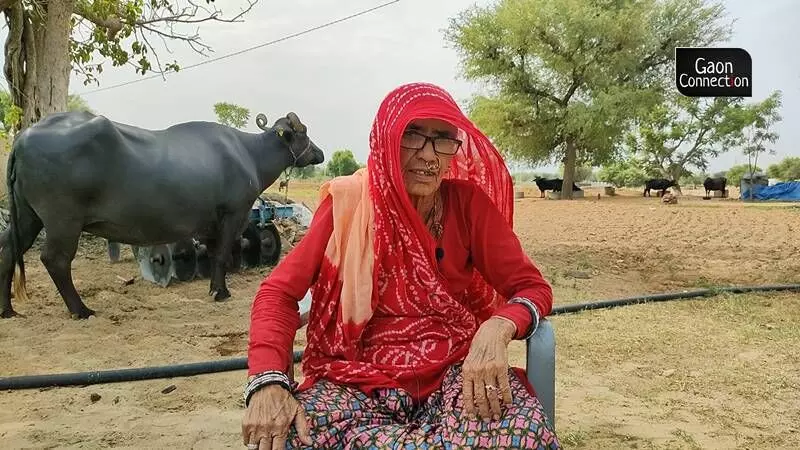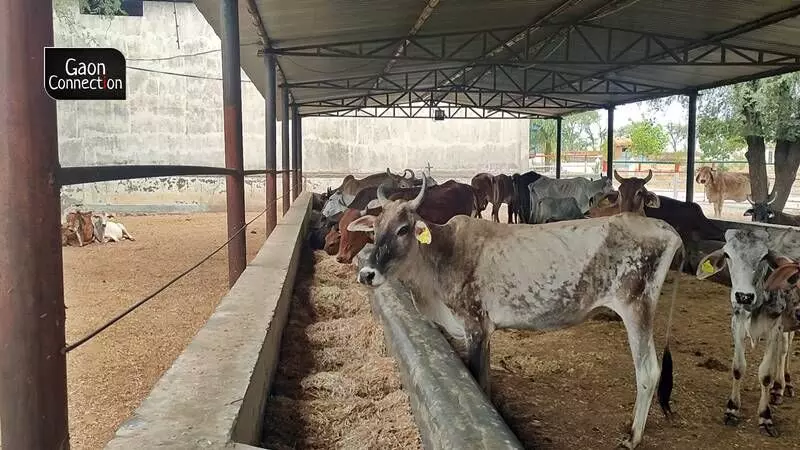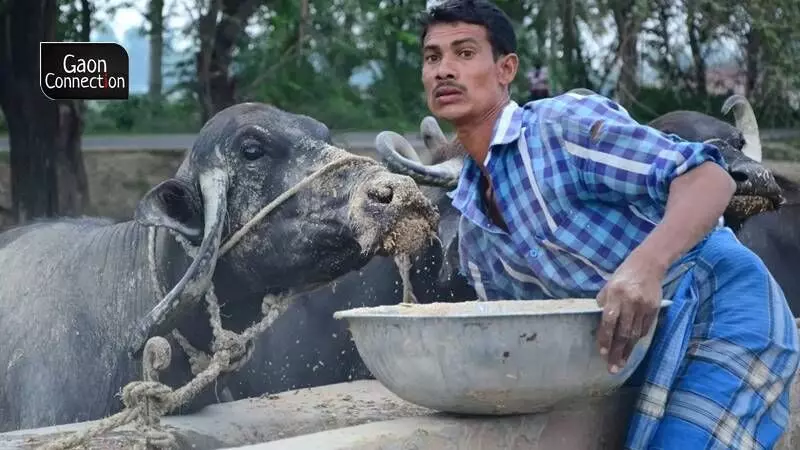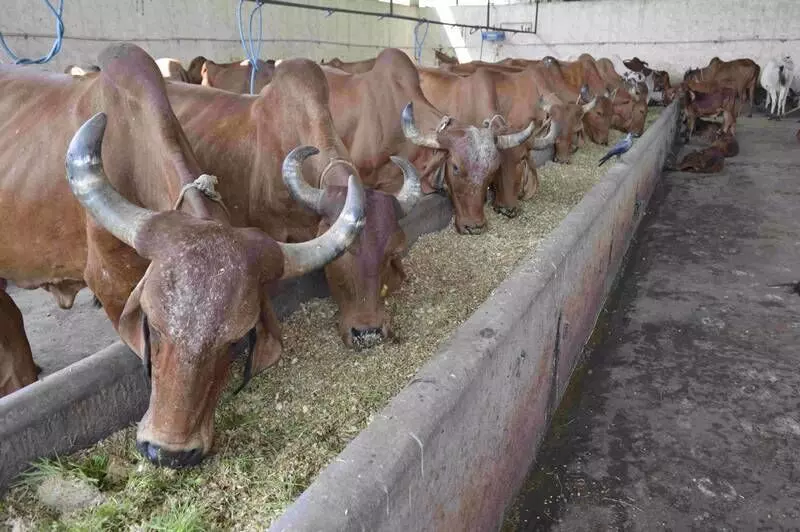Dhanakya village (Jaipur), Rajasthan
Having grown up in a household which, for generations, has depended on dairy farming for its livelihood, not being able to afford fodder for his cattle has dismayed 45-year-old Mahesh Yadav.
“I had a total of 31 animals including nine buffaloes and 19 cows in my tabela (cattle shed). Now, I am left with only 14 animals,” Yadav, a cattle rearer from Dhanakya village in Rajasthan’s Jaipur district, told Gaon Connection. “I had no option but to sell my cattle as skyrocketing fodder prices made it impossible for me to sustain losses any longer. I haven’t seen such high fodder prices ever,” he added.
According to him, fodder prices that hovered around Rs 500-Rs 700 per quintal (100 kilogrammes) last year have increased over three times and jumped to Rs 1,300 to Rs 1,800 per quintal this year.
“I used to earn a profit of Rs 30,000 to Rs 35,000 from dairy farming every month but these days that’s exactly how much losses I am incurring on a monthly basis. It is impossible to derive a livelihood from animal husbandry these days,” he said.
As per the 20th Livestock Census which was released in 2019, Rajasthan has the second highest number of livestock population in the country (next only to Uttar Pradesh) with a population of 56.8 million animals. Of these, 139 million are cattle and 137 million are buffaloes.
The cattle rearers in the state are at their wit’s end as spiralling fodder prices, prolonged heat and water scarcity is forcing them to sell their cattle at throwaway prices. Some are even abandoning them.
“I sold my two buffaloes at Rs 24,000! Had there been no shortage of fodder and I wasn’t desperate, I would have sold them for one lakh rupees,” Manbhar Devi, a 70-year-old resident of Mundiya Ramsar village in Jaipur, told Gaon Connection.

Manbhar Devi (Photo by Somu Anand)
Pravesh Lal Verma has been operating a cattle shelter in Nimeda village of Jaipur for the past 20 years. “I have never seen fodder being sold at such high prices. Many cattle rearers are sending their animals to our shelters. Initially we accepted some 20-25 cows but now we have stopped the entry of new animals. Where would we provide the fodder from?” Verma asked in a helpless tone. “The government’s efforts are not sufficient to help cattle shelters like this one,” he added.
Many cattle rearers told Gaon Connection on the condition of anonymity that they have no option but to gradually decrease the fodder intake of their animals resulting in their ultimate death from starvation.
“We cannot give away our cattle to butchers. We gradually starve them to death. I know it is unfair but we are left with no options,” a cattle-rearer from Jaipur district told Gaon Connection.
Also Read: Mango production in India to be hit due to early arrival of heatwaves
‘Low wheat production biggest contributor to fodder shortage’
Gaon Connection spoke with the sector experts who informed that a lower wheat production this year, preference for less water-intensive cash crops like mustard, and the ban on inter-state transport of fodder have all contributed to the fodder shortage.
They agreed that the lower production of wheat crop has single handedly been the biggest factor that has caused a shortage of fodder in the markets. Wheat crop, after the harvest and removal of the grain, is used as fodder.
On the basis of the Third Advance Estimates of Production of Foodgrains for 2021-22, Union Ministry of Agriculture and Farmers’ Welfare stated last month on May 19 that the production of wheat is projected to be 106.41 million tonnes for the month of June 2022, which falls short of the official target of 110 million tonnes by 3.59 million tonnes and lower than last year’s production by 3.18 million tonnes.

Many cattle rearers told Gaon Connection on the condition of anonymity that they have no option but to gradually decrease the fodder intake of their animals resulting in their ultimate death from starvation.
Also Read: Rising exports, low procurement and a drop in wheat yield: Is India headed for a wheat shortage?
The lower production of wheat this year has been attributed to the early onset of heatwaves during the month of March. Gaon Connection has extensively reported on this issue.
Manibhushan Jha, a researcher working for World Resources Institute-India, a Washington DC-based research, told Gaon Connection that the destructive heatwaves are here to stay as the summers are observed to be getting hotter every year.
“If you look at the temperatures recorded in the summer months in India, you will notice that almost every year, records for maximum temperatures are being broken. Carbon emissions are almost doubled in last hundred years which are contributing to global warming and its impact on agriculture and allied sectors is being felt across the globe,” Jha said.
Also Read: Bonanza for Indian wheat exporters, but cuts in wheat quota under the PM Garib Kalyan Anna Yojana
No water for cattle
Rising and prolonged heat has also resulted in acute wheat shortage in rural India. As part of Gaon Connection‘s Paani Yatra series, ground reports have been published highlighting the water crisis in the hinterland. And this crisis has hit cattle rearers too.
“Cattle rearers like me have to order water tankers in order to provide water to the animals on a daily basis. A single tanker costs Rs 500. If these challenges stick around for long, I’ll have to wrap up my dairy operations and look for another source of livelihood,” Mukesh Yadav, a dairy farmer from Dhanakya village said.
Rampyari Devi, a 55-year-old resident of the Dhanakya village, told Gaon Connection that a cow which produces 20 litres of milk in a day needs at least ten kilograms of fodder and about 70-80 litres of water.
“The fodder which cost Rs 6-Rs 7 last year is now being sold at Rs 14 to Rs 18 this year. Also, there is no borewell in my village, we have to buy water from the tanker. Also, medicines and nutritional supplements are also needed by the animals. Rearing a single cow these days costs about Rs 400 on a daily basis,” she said.
The worries of these cattle rearers are compounded by a disproportionate rise of milk prices. “In our village, cow milk gets sold at Rs 30 per litre. Even in cities, the prices haven’t risen much. The milk price should be way higher than what it is if we account for profits of farmers like us,” Rampyari Devi said.
Also Read: A Midsummer Pipe Dream: Pipelines laid down and taps installed, but where is the water?
Farmers preferring cash crops over wheat
Experts also opine that the falling water levels and better prices of cash crops are motivating farmers to cultivate crops like mustard and there is general lack of initiative to grow wheat.
Kishan Lal Jeengar, dean of the Bhilwara-based College of Agriculture, told Gaon Connection that since mustard is a less water-intensive crop as compared to wheat, it has left no option for farmers in water-scarce areas but to do away with the cultivation of wheat.

The cattle rearers in the state are at their wit’s end as spiralling fodder prices, prolonged heat and water scarcity is forcing them to sell their cattle at throwaway prices. Some are even abandoning them.
“A mustard crop requires one or two sessions of water supply while wheat requires five to six such sessions. As a result, many farmers in Rajasthan have preferred to grow mustard and gram rather than the traditional crop of wheat,” Jeengar said. Although it might be beneficial for the farmers, it has resulted in a shortage of fodder for animal rearers, the dead added.
Jeengar’s opinion holds ground as according to the Department of Agriculture of the Rajasthan government, mustard was cultivated on 3.387 million hectares of land (2021-22) which is way above the official target of 2.8 million hectares. On an average, 2.539 million hectares of land was used for the cultivation of mustard in the last five years.
Also, the acreage of wheat in the state has declined from a five-year average of 3.2 million hectares to 2.7 million hectares in this season. The official target for wheat acreage was 3 million hectares this year.
Curbs on inter-state transport of fodder
Lalchand Sharma, a farmer from Rajasthan’s Sri Ganganagar district complained that curbs on transport of fodder from the nearby states is adding fuel to the crisis in Rajasthan.
“Many brick kiln operators in Haryana and Punjab use straw as fuel in their furnaces. As a result, these states have put curbs on the transport of fodder to other states. Our animals are starving because of these curbs,” Sharma told Gaon Connection.
On April 25, Haryana banned the inter-district and inter-state transport of fodder in a bid to address its shortage. However, a day later on April 26, the state’s agricultural minister Jai Prakash Dalal announced on Twitter that there was no restriction on transport of fodder from within the state but its inter-state transport has been curbed to cope with regional shortages within the state. Also, several districts in Madhya Pradesh such as Morena and Sehore issued orders banning the transport of fodder to other states during March-April.
किसान भाई अफवाहों पर ध्यान ना दें, प्रदेश में चारे की अंतर-जिला आवाजाही पर कोई प्रतिबंध नहीं है, इसलिए सभी जिले आपसी तालमेल के साथ चारे की उपलब्धता करवाना सुनिश्चित करें। हालांकि चारे की स्थानीय आवश्यकताओं को पूरा करने के लिए केवल अंतर-राज्यीय आवाजाही पर प्रतिबंध लगाया गया है।
— Jai Parkash Dalal (@JPDALALBJP) April 26, 2022
When Gaon Connection contacted the joint director of the Rajasthan government’s Department of Animal Husbandry, it was learnt that the department officials have been dispatched to the states of Haryana, Madhya Pradesh, and Punjab to assess the fodder requirements and persuade the state governments to remove the curbs on the transport of fodder to other states.
पशु चारा का जिले की सीमाओं के बाहर निर्यात पर प्रतिबंध – कलेक्टर
–
मुरैना जिले में पशुधन की संख्या को दृष्टिगत रखते हुये ग्रीष्मकाल में चारे की उपलब्धता सुनिश्चित करने हेतु पशुचारा का जिले की सीमाओं के बाहर निर्यात पर कलेक्टर श्री बी.कार्तिकेयन ने प्रतिबंध लगा दिया है।— Collector Morena (@collectormorena) April 25, 2022
“We are regularly communicating with our counterparts from the nearby states. Our teams have offered that if the Rajasthan government provides subsidy to the transport cost of fodder from other states, the fodder prices can be regulated,” Mahesh Yadav, the joint director said.

The lower production of wheat crop has single handedly been the biggest factor that has caused a shortage of fodder in the markets.
“Also, we asked the state disaster management department to check hoarding of fodder by traders. No trader is allowed to store more than 100 tonnes (100,000 kilogrammes) of fodder in their facilities,” he added.
Additionally, Secretary of the Department of Agriculture told Gaon Connection that his department is trying to ensure that the acreage of the upcoming crop of bajra (pearl millet) is raised to compensate for the reduction in the acreage of wheat.
‘Govt not doing enough to address fodder crisis’
Meanwhile, Harvinder Singh Barar, a social activist from Sri Ganganagar told Gaon Connection that the administrative steps taken to address the shortage of fodder in the state are not satisfactory.
“On one hand, the Union government is trying to provide access to farmers to markets across the country, on the other hand states are putting curbs on the sale of fodder to other states. How will this attitude solve the woes of the farming sector?” he said.
The activist also claimed that around 1.7 million hectares of arable land in Rajasthan is illegally encroached.
“The government can utilise the cow cess revenue to arrange for the fodder. Also, the labourers under the MGNREGA (rural employment scheme) can be utilised to create grazing spaces on the barren lands. This will not only reduce the dependence of animal rearers on fodder but also help in efficient utilisation of MGNREGA labour,” he added.


















